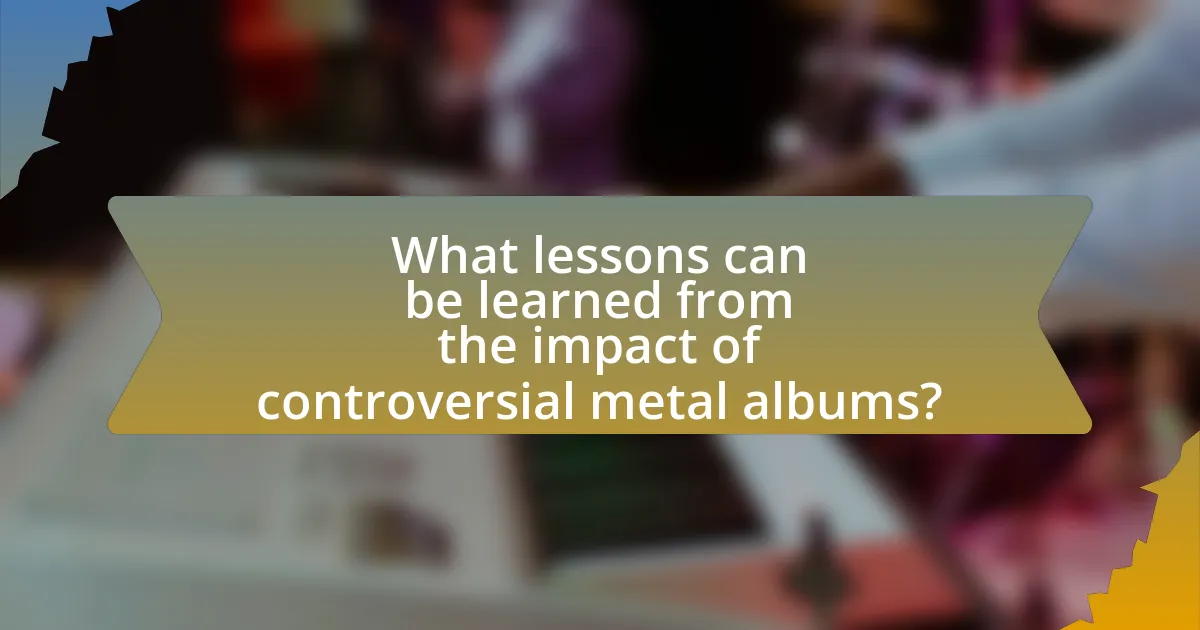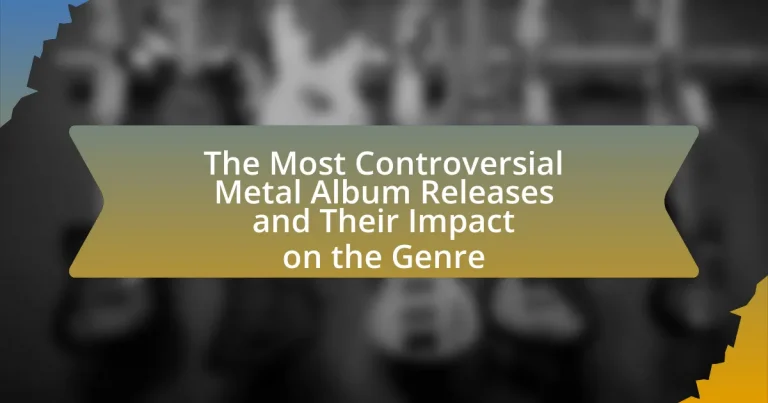The article examines the most controversial metal album releases and their significant impact on the genre. Key albums discussed include Metallica’s “The Black Album,” Marilyn Manson’s “Antichrist Superstar,” and the collaboration “Lulu” by Metallica and Lou Reed, each provoking strong reactions due to their themes and stylistic shifts. The article explores why certain albums are deemed controversial, the themes that contribute to this perception, and how fan reactions shape their legacy. Additionally, it addresses the social implications of these albums, the dynamics within the metal community, and the broader discussions about censorship and artistic freedom that arise from such controversies.

What are the most controversial metal album releases?
The most controversial metal album releases include “The Black Album” by Metallica, “Antichrist Superstar” by Marilyn Manson, and “Lulu” by Metallica and Lou Reed. “The Black Album,” released in 1991, faced backlash for its mainstream appeal, diverging from Metallica’s thrash roots, which alienated some fans. “Antichrist Superstar,” released in 1996, sparked outrage due to its provocative themes and imagery, leading to protests and censorship attempts. “Lulu,” released in 2011, was criticized for its avant-garde style and perceived lack of cohesion, resulting in polarized reviews and fan reactions. Each of these albums significantly impacted the genre by challenging norms and provoking discussions about artistic expression in metal.
Why are certain metal albums considered controversial?
Certain metal albums are considered controversial due to their provocative themes, explicit lyrics, and imagery that challenge societal norms. For instance, albums like “Holy Wars… The Punishment Due” by Megadeth address political and religious issues, sparking debates about freedom of expression and the role of music in social commentary. Additionally, Cannibal Corpse’s “Butchered at Birth” features graphic artwork and lyrics that depict violence and gore, leading to censorship and bans in various countries. These elements often provoke strong reactions from audiences and critics alike, highlighting the genre’s ability to confront taboo subjects and push boundaries.
What themes or content contribute to the controversy of these albums?
Controversial metal albums often feature themes such as violence, anti-religion, and explicit sexuality, which provoke strong reactions from audiences and critics alike. For instance, albums like “Holy Wars… The Punishment Due” by Megadeth address political and religious conflicts, sparking debates about the role of music in social issues. Similarly, Cannibal Corpse’s graphic depictions of violence in their lyrics have led to censorship and bans in various countries, highlighting the clash between artistic expression and societal norms. These themes not only challenge listeners’ sensibilities but also reflect broader cultural tensions, making them focal points for controversy within the genre.
How do fan reactions shape the perception of these controversial albums?
Fan reactions significantly shape the perception of controversial albums by influencing public discourse and media coverage. When fans express strong opinions, whether positive or negative, it creates a narrative that can amplify or diminish the album’s impact. For instance, the backlash against Metallica’s “St. Anger” led to widespread criticism, which was echoed in reviews and discussions, ultimately affecting its legacy. Conversely, the enthusiastic reception of Slayer’s “Reign in Blood” helped solidify its status as a classic, demonstrating how fan enthusiasm can elevate an album’s reputation. This dynamic illustrates that fan engagement not only reflects but also actively constructs the cultural significance of controversial releases in the metal genre.
Which albums have sparked significant debate within the metal community?
Albums that have sparked significant debate within the metal community include Metallica’s “Load,” Slayer’s “Diabolus in Musica,” and Sepultura’s “Roots.” “Load” faced criticism for its departure from thrash metal roots, incorporating more rock elements, which alienated some fans. Slayer’s “Diabolus in Musica” was controversial for its experimentation with nu-metal influences, leading to mixed reactions from long-time followers. Sepultura’s “Roots” generated debate due to its fusion of metal with Brazilian tribal music, challenging traditional metal norms and polarizing listeners. These albums exemplify how shifts in musical direction can provoke strong opinions and discussions within the genre.
What specific incidents or events are associated with these albums?
Specific incidents associated with controversial metal albums include the release of “Satanic Verses” by Deicide, which led to protests and accusations of blasphemy from religious groups. Another significant event is the backlash against Metallica’s “Load,” which faced criticism for its departure from traditional metal aesthetics, resulting in a divided fanbase. Additionally, Slayer’s “Reign in Blood” sparked discussions about violence in music, particularly after its association with real-life violent incidents. These events illustrate the profound impact these albums had on public perception and the genre’s evolution.
How have critics responded to these controversial releases?
Critics have responded to these controversial metal album releases with a mix of condemnation and praise, reflecting the polarized nature of the genre. For instance, albums like “The Black Album” by Metallica faced backlash for its mainstream appeal, yet it also garnered acclaim for its musical evolution, evidenced by its multi-platinum sales and significant influence on the genre. Similarly, Slayer’s “God Hates Us All” received criticism for its provocative themes but was praised for its raw energy and musicianship, as highlighted by its high ranking on various music charts. This duality in critical reception illustrates how controversial releases can challenge norms while simultaneously pushing the boundaries of metal music.

How have controversial metal albums impacted the genre?
Controversial metal albums have significantly shaped the genre by challenging societal norms and pushing artistic boundaries. Albums such as “Satanic” by Venom and “The Black Album” by Metallica sparked debates around themes of violence, religion, and morality, leading to increased media attention and public discourse. This attention often resulted in a broader audience for metal music, as controversy attracted listeners who may not have engaged with the genre otherwise. Additionally, the backlash against these albums sometimes fueled the creation of subgenres, such as black metal and death metal, which embraced extreme themes and aesthetics. The impact of these albums is evident in the way they have influenced subsequent artists and the evolution of metal as a diverse and multifaceted genre.
What changes in musical style have emerged from these controversial releases?
Controversial metal album releases have led to significant changes in musical style, particularly through the incorporation of diverse influences and experimentation with genre boundaries. For instance, albums like “The Black Album” by Metallica introduced a more mainstream sound, blending heavy metal with hard rock elements, which expanded the genre’s appeal. Similarly, Slipknot’s self-titled album integrated nu-metal with elements of hip-hop and industrial music, pushing the boundaries of traditional metal. These shifts have resulted in a broader acceptance of varied musical styles within the metal community, encouraging artists to explore unconventional sounds and themes, ultimately reshaping the genre’s landscape.
How have these albums influenced new subgenres within metal?
These albums have significantly influenced new subgenres within metal by introducing innovative musical elements and thematic content that diverged from traditional metal norms. For instance, the incorporation of extreme vocal techniques and complex song structures in albums like “Blackwater Park” by Opeth has led to the emergence of progressive death metal, while the fusion of electronic elements in “The Way of All Flesh” by Gojira has contributed to the development of djent and metalcore subgenres. Additionally, the controversial themes and lyrical content in albums such as “Antichrist Superstar” by Marilyn Manson have paved the way for shock rock and industrial metal, showcasing how these releases have reshaped the landscape of metal by inspiring new stylistic directions and subgenre classifications.
What role do controversial albums play in shaping the identity of metal music?
Controversial albums play a significant role in shaping the identity of metal music by challenging societal norms and pushing artistic boundaries. These albums often provoke strong reactions, which can lead to increased visibility and discussion within the genre. For instance, albums like “Screaming for Vengeance” by Judas Priest and “The Black Album” by Metallica sparked debates about commercialism versus authenticity in metal, influencing the genre’s evolution. Additionally, the backlash against albums such as “Antichrist Superstar” by Marilyn Manson highlighted the genre’s association with rebellion and anti-establishment sentiments, reinforcing its identity as a platform for controversial expression. This interplay between controversy and identity not only defines the genre but also attracts diverse audiences, solidifying metal’s place in the broader music landscape.
How do controversial albums affect the metal community’s dynamics?
Controversial albums significantly impact the dynamics of the metal community by provoking intense discussions and polarizing opinions among fans. These albums often challenge societal norms or musical conventions, leading to debates about artistic expression and the boundaries of the genre. For instance, albums like “The Black Album” by Metallica and “Antichrist Superstar” by Marilyn Manson sparked widespread discourse regarding commercialism and shock value in metal. Such discussions can either unite fans in defense of their favorite artists or create rifts between differing ideologies within the community. Additionally, controversial content can attract new listeners who are intrigued by the debates, thereby expanding the audience and influencing the evolution of the genre.
What are the social implications of these albums on fans and artists?
The social implications of controversial metal albums on fans and artists include the fostering of community identity and the promotion of dialogue around taboo subjects. Fans often find a sense of belonging and validation in the themes explored in these albums, which can address issues like mental health, societal norms, and personal struggles. For instance, albums that tackle themes of alienation or rebellion resonate deeply with listeners, creating a shared experience that strengthens fan communities.
Artists, on the other hand, may face backlash or censorship due to the provocative nature of their content, which can lead to discussions about artistic freedom and societal values. The release of albums like “The Black Album” by Metallica or “The Downward Spiral” by Nine Inch Nails sparked conversations about the boundaries of expression in music, influencing both public perception and the artists’ careers. These dynamics illustrate how controversial albums can serve as catalysts for social change and reflection within both fan bases and the broader cultural landscape.
How do controversies lead to discussions about censorship and artistic freedom?
Controversies surrounding metal albums often spark discussions about censorship and artistic freedom by highlighting the tension between creative expression and societal norms. For instance, albums like “As Nasty As They Wanna Be” by 2 Live Crew faced legal challenges due to explicit content, prompting debates on whether such censorship infringes on artistic rights. These discussions are fueled by the recognition that artistic expression can provoke strong reactions, leading to calls for censorship from various groups, which in turn raises questions about the limits of free speech in art. Historical instances, such as the PMRC’s attempts to regulate music content in the 1980s, illustrate how controversies can mobilize artists and advocates to defend their creative freedoms against perceived overreach.

What lessons can be learned from the impact of controversial metal albums?
Controversial metal albums teach the importance of artistic expression and the potential for music to challenge societal norms. These albums often provoke discussions about censorship, freedom of speech, and the boundaries of art, as seen with albums like “Satanic” by Venom and “The Black Album” by Metallica, which sparked debates on themes of violence and morality. The backlash faced by these albums illustrates how music can serve as a catalyst for cultural dialogue, pushing listeners to confront uncomfortable topics. Additionally, the commercial success of many controversial albums demonstrates that provocative content can resonate with audiences, leading to increased visibility for the genre and its artists.
How can artists navigate controversy in their music effectively?
Artists can navigate controversy in their music effectively by maintaining authenticity while engaging in open dialogue with their audience. This approach allows artists to express their perspectives without alienating listeners. For instance, bands like Metallica have addressed controversial themes in their lyrics while also participating in discussions about societal issues, which helps to contextualize their music and mitigate backlash. Additionally, artists can utilize social media platforms to clarify their intentions and respond to criticism in real-time, fostering a sense of transparency. This strategy has been shown to enhance fan loyalty, as seen in the case of bands like Slipknot, who actively engage with their fanbase during controversies.
What strategies can be employed to address backlash from controversial content?
To address backlash from controversial content, organizations can implement strategies such as proactive communication, audience engagement, and transparent accountability. Proactive communication involves clearly articulating the intent and context behind the controversial content, which can help mitigate misunderstandings. Audience engagement includes actively listening to feedback and addressing concerns through dialogue, fostering a sense of community and understanding. Transparent accountability means acknowledging mistakes and taking responsibility for any negative impact, which can rebuild trust and credibility. These strategies are supported by case studies in crisis management, such as the response strategies employed by brands during public relations crises, which demonstrate that effective communication and engagement can significantly reduce backlash.
How can artists use controversy to enhance their message or brand?
Artists can use controversy to enhance their message or brand by provoking strong emotional reactions and sparking discussions that elevate their visibility. For instance, controversial themes in lyrics or album artwork can challenge societal norms, prompting audiences to engage more deeply with the artist’s work. A notable example is the band Cannibal Corpse, whose graphic album covers and lyrics have generated significant media attention, ultimately solidifying their brand identity within the extreme metal genre. This strategy not only attracts attention but also fosters a loyal fan base that appreciates the artist’s willingness to tackle taboo subjects, thereby reinforcing their message and brand.
What best practices should be considered when discussing controversial albums?
When discussing controversial albums, it is essential to approach the topic with respect and an open mind. Engaging in active listening and acknowledging differing perspectives fosters a constructive dialogue. Additionally, providing context about the album’s themes, historical background, and the artist’s intent can enhance understanding. Citing specific examples or critical reviews can support arguments and clarify points of contention. Furthermore, avoiding personal attacks and focusing on the music itself helps maintain a respectful conversation. These practices contribute to a more informed and balanced discussion about controversial albums in the metal genre.
How can fans engage in constructive dialogue about controversial themes in metal?
Fans can engage in constructive dialogue about controversial themes in metal by actively listening to differing viewpoints and fostering respectful discussions. Engaging in forums, social media groups, or local meetups allows fans to share their perspectives while considering the historical and cultural contexts of controversial albums, such as Slayer’s “Reign in Blood,” which sparked debates on violence and morality in music. By referencing specific examples and encouraging open-mindedness, fans can create a space for nuanced conversations that promote understanding rather than conflict.
What resources are available for understanding the context of controversial releases?
Resources available for understanding the context of controversial releases in metal music include academic journals, music history books, and online databases. Academic journals such as “Popular Music” and “Journal of Popular Music Studies” provide peer-reviewed articles analyzing the cultural and social implications of controversial albums. Music history books, like “Metallica: This Monster Lives” by Joe Berlinger, offer insights into specific releases and their impact on the genre. Online databases like JSTOR and Google Scholar allow access to a wide range of scholarly articles and theses that discuss the controversies surrounding various metal albums, providing a comprehensive understanding of their context.


